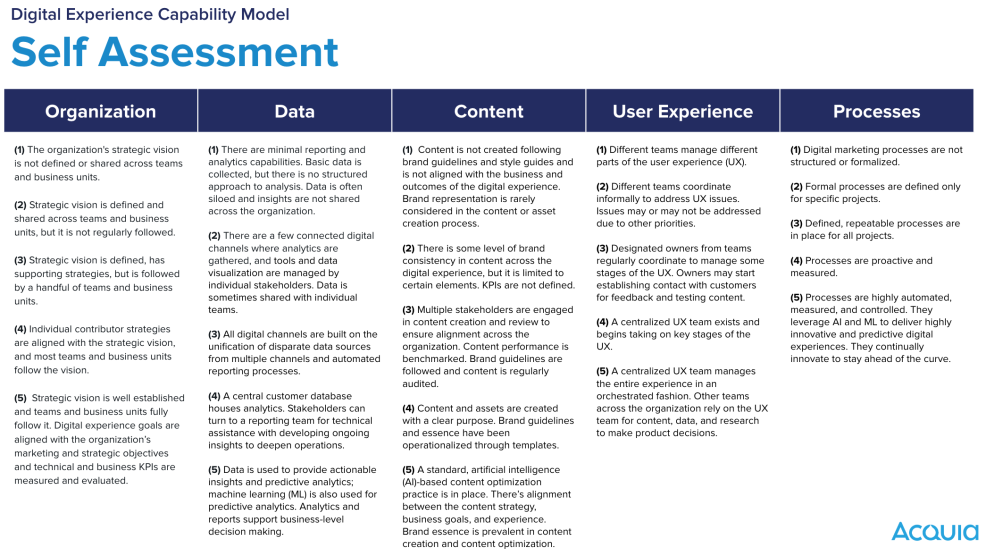
How a Digital Experience Capability Model Unlocks Competitive Advantage: The Acquia Model

As customer expectations for digital experiences (DX) rise, and the tools and channels available to marketers proliferate, organizations struggle with where to begin in ensuring the delivery of consistently excellent DX. A digital experience platform (DXP) is part of the solution, but creating productive digital experiences isn’t only about technology. As marketing teams think holistically, they may ask themselves, “What capabilities do we have? Where do we need to focus to get the best return?”
Because Acquia has a long history of building superior digital experiences with amazing brands — Finastra, Hologic, and Mars just to name a few — we’ve developed the Digital Experience Capability Model (DXCM) to help organizations answer those very questions. The model offers a methodology for objectively measuring the strengths and weaknesses of an organization’s ability to create productive digital experiences across five core competencies. We then take a “heat map” approach and use a scale from one to five to see where an organization falls across those competencies.
This model was designed not only to assess strengths and weaknesses and where marketing efforts may begin, but also to determine key performance indicators (KPIs) that align to desired business outcomes. Lastly, the DXCM helps uncover business justifications for building more productive digital experiences.
Let’s dig into its tenets.
Five core business capabilities
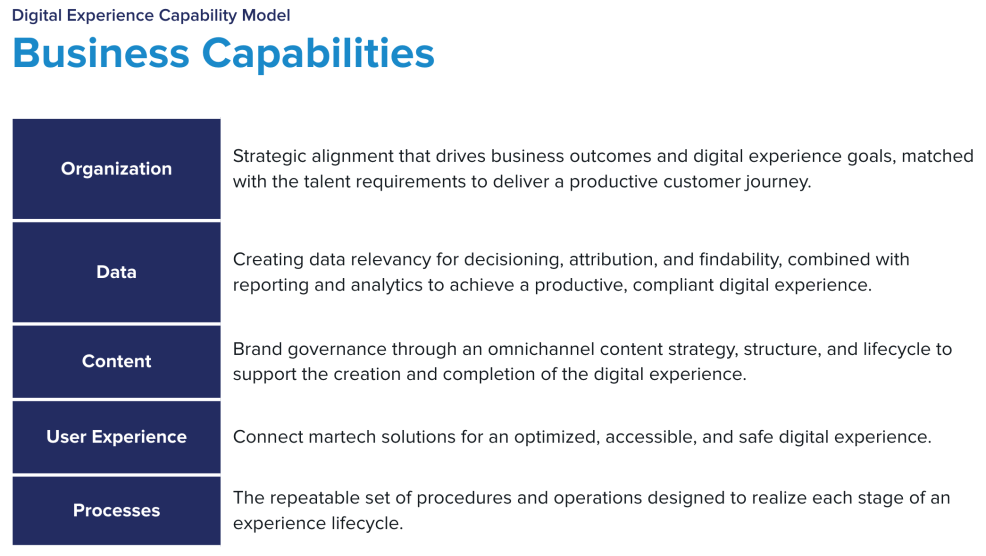
At bottom, a good DXCM provides organizations with clarity. It identifies where there’s misalignment and offers a clear path forward to digital excellence. Getting there means investing in the technologies that:
- Produce personalized digital experiences built on cross-functional customer experience (CX) capabilities and an understanding of the capabilities most critical to productive customer journeys
- Deliver frictionless CX by documenting the DX capabilities that best manage integrations and support the purchase journey
Reaching those objectives requires focused evaluation of five core business capabilities that we’ve outlined in the DXCM:
- Organization. This capability measures the strategic alignment across teams to determine if outcomes are shared and resources are aligned across those strategic goals. Common questions that address this capability include: To what extent is the company’s strategic vision defined? What talent is needed to fulfill the vision?
It helps identify key stakeholders, allocate responsibilities, and create cross-functional teams. This capability ensures that everyone involved in the DX development process understands their role, fostering collaboration and a shared vision.
- Data integration. Information is the lifeblood of any DXP because you can only create compliant and personalized experiences with relevant data shared between teams. By understanding data requirements, organizations can make informed decisions and implement robust data governance. Typical questions for assessing this capability include: How easily can the organization access its data and report findings? What are its analytics capabilities?
- Content management. Content is at the heart of user engagement, so this capability looks for alignment between content strategy, business goals, and user experience. It enables organizations to define content strategies, identify content creators and curators, and establish workflows for content creation and publication, resulting in digital experiences and content that’s relevant, accessible, and high quality. When executed properly, user satisfaction and loyalty increase.
Questions that address this capability include: Does content follow brand guidelines? Who creates content, and how does it perform? Are content and related assets on brand? Do the content strategy, business objectives, and digital experience align?
- User experience (UX). This capability guides organizations in creating user personas, mapping user journeys, and incorporating design thinking principles. By focusing on UX, organizations can enhance the overall satisfaction of users, increase usability, and differentiate the digital experiences they serve from those of their competitors. The capability should be centralized for the entire organization, not across multiple groups. Critically, user feedback needs to inform DX development.
Common questions to ask around this capability include: Who is responsible for designing and orchestrating the UX? How do their findings affect product decisions? Is the UX accessible for all?
- Connected processes. Efficient processes are the backbone of DX development, so organizations need a repeatable set of procedures and operations that maximize the lifecycle of a DX. This capability identifies and optimizes key processes, enabling cross-team collaboration workflows and the implementation of agile methodologies. Signs that this capability is at a high level include use of artificial intelligence and machine learning technologies that demonstrate predictability and automation.
Questions that address this capability include: Are processes manual or automated? Are they formal? Can they be repeated, and do they have measurable outputs?
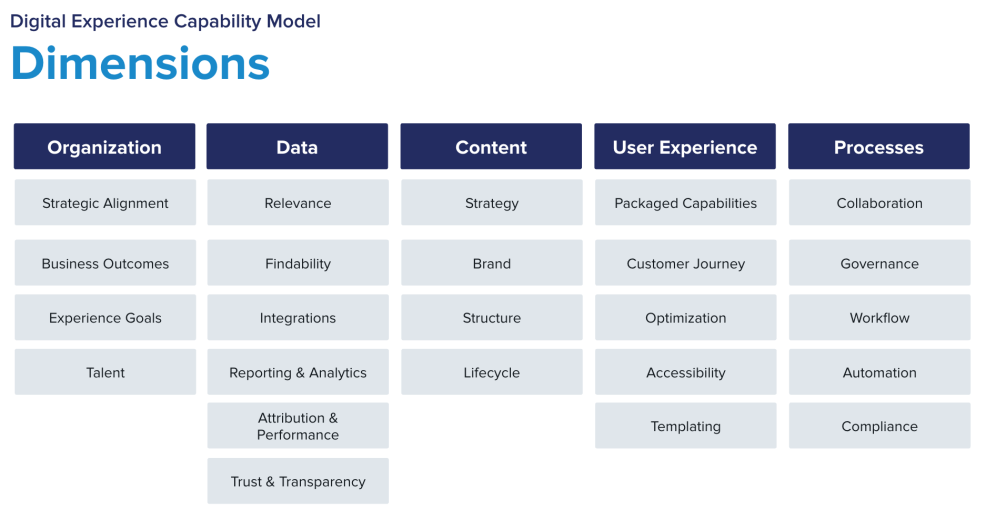
Measuring capabilities
At Acquia, we believe these five capabilities are the success criteria by which organizations must assess any solution they’re considering for the delivery of digital experiences that drive positive business outcomes. We measure them on a capability scale of five stages:
- Initial
- Emerging
- Standardizing
- Operationalizing
- Optimizing
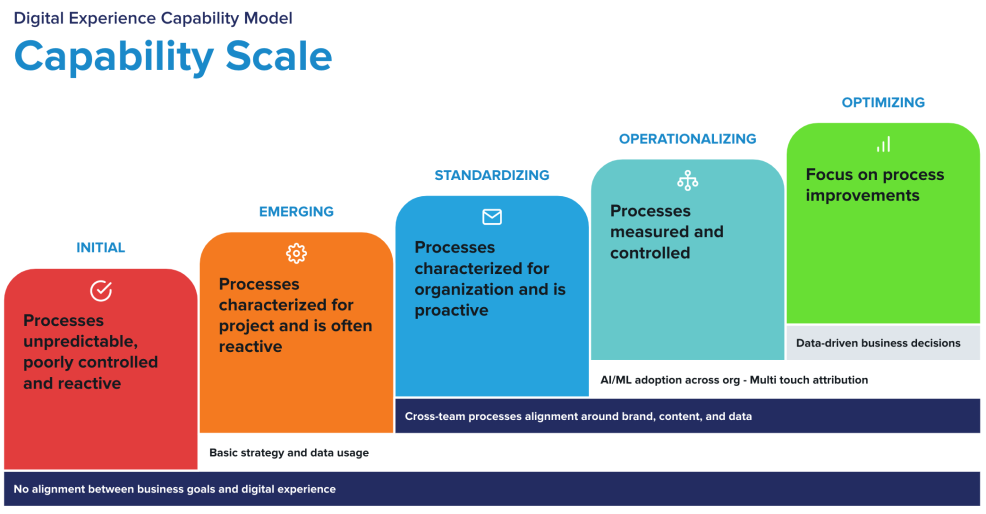
So, if we were to assess a capability like data integration:
- An organization at the Initial stage may have minimal reporting and analytics capabilities. Basic data may be collected, but there’s no real structural approach to it. Data is often siloed and not shared companywide.
- In the Emerging stage, data usage has begun, and there’s a basic strategy in place.
- Moving on to the Standardizing stage, cross-team collaboration is occurring, and there’s alignment around branding, content, and data.
- At the Operationalizing stage, artificial intelligence (AI) and machine learning (ML) technologies have been adopted across the company, and multitouch attribution can be measured.
- At the highest level or Optimizing stage, centralized data is used for predictive actions that inform business decisions.
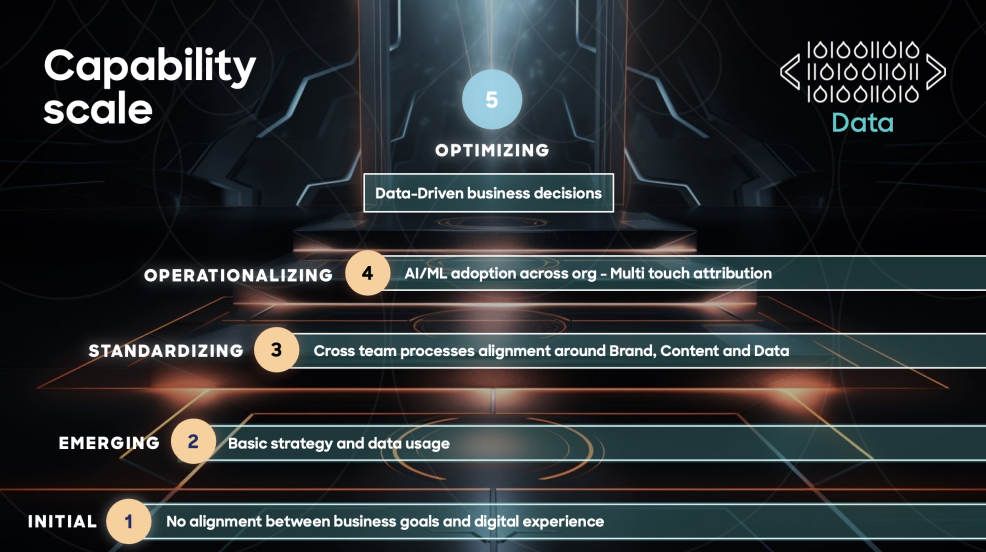
An evaluation that uses a capability scale like the one above allows partners and organizations to more accurately assess their ability to serve the digital experiences that differentiate them from competitors.
Next steps
Applying a digital experience capability model to your marketing efforts can be daunting for any organization. Fortunately, a partner like Acquia can act as a guide. We regularly see organizations stumble as they navigate the ever-shifting martech landscape and find that a DXCM prompts leaders to better articulate the issues they face, lending them surer footing.
For example, an organization may struggle with a chaotic content workflow in which assets are stored in various locations. Where one vendor may hear “assets” and immediately propose a solution like a digital asset management (DAM) system, we query further to discover a deeper problem: brand management. By identifying the larger issue, we can design a holistic solution that sees the bigger picture, avoids redundant technologies, and results in productive customer journeys that, in turn, grow ROI.
We’ve prepared a self-assessment guide below for organizations that want to try the Acquia DXCM for themselves and are on hand to work directly with teams. Reach out to Acquia today!
